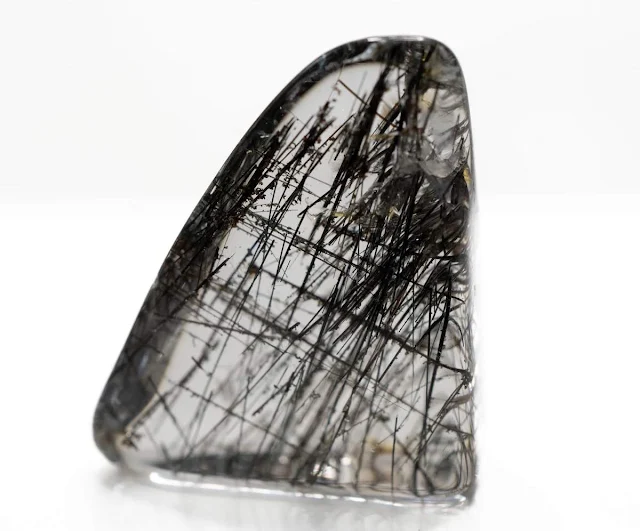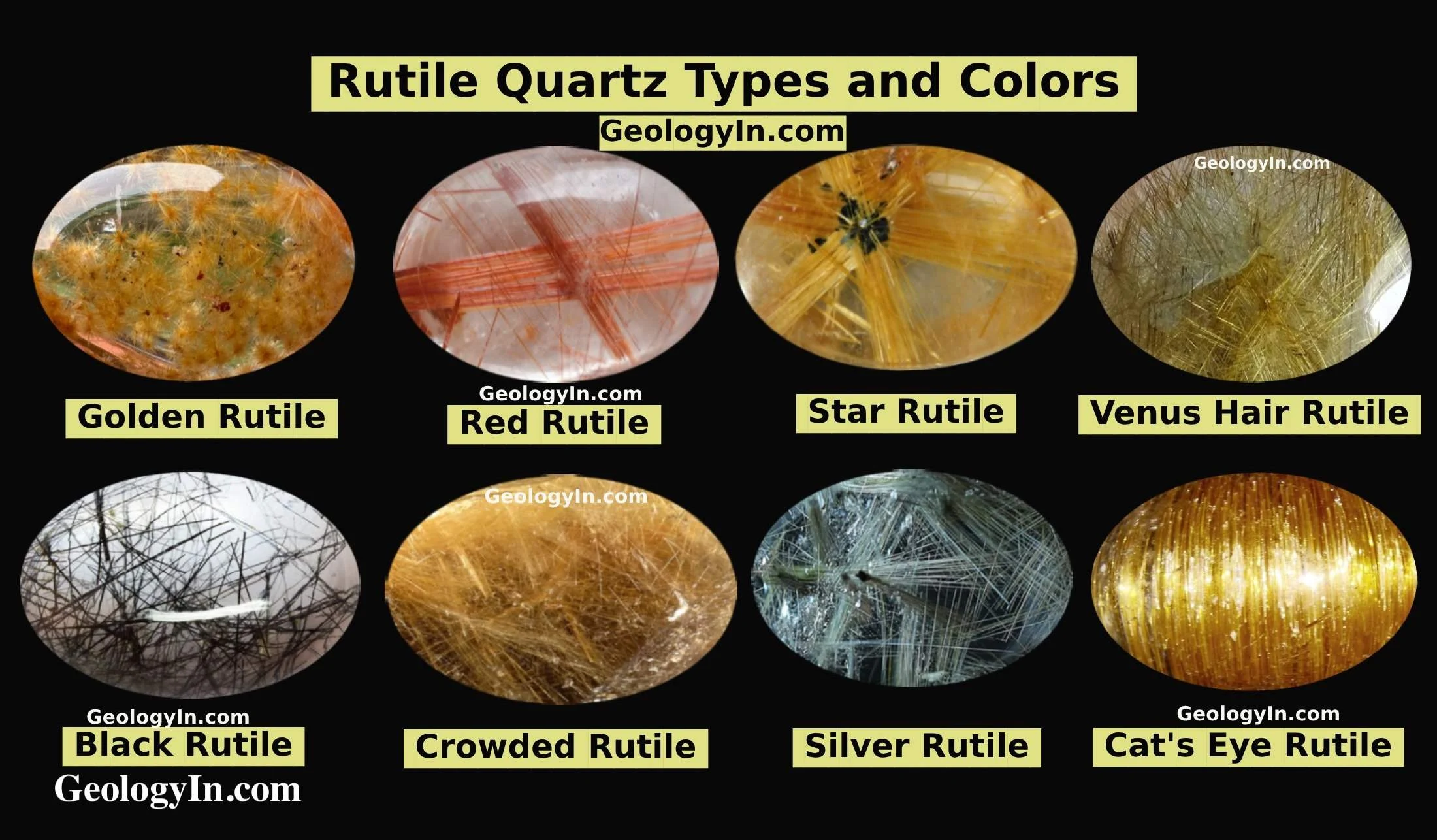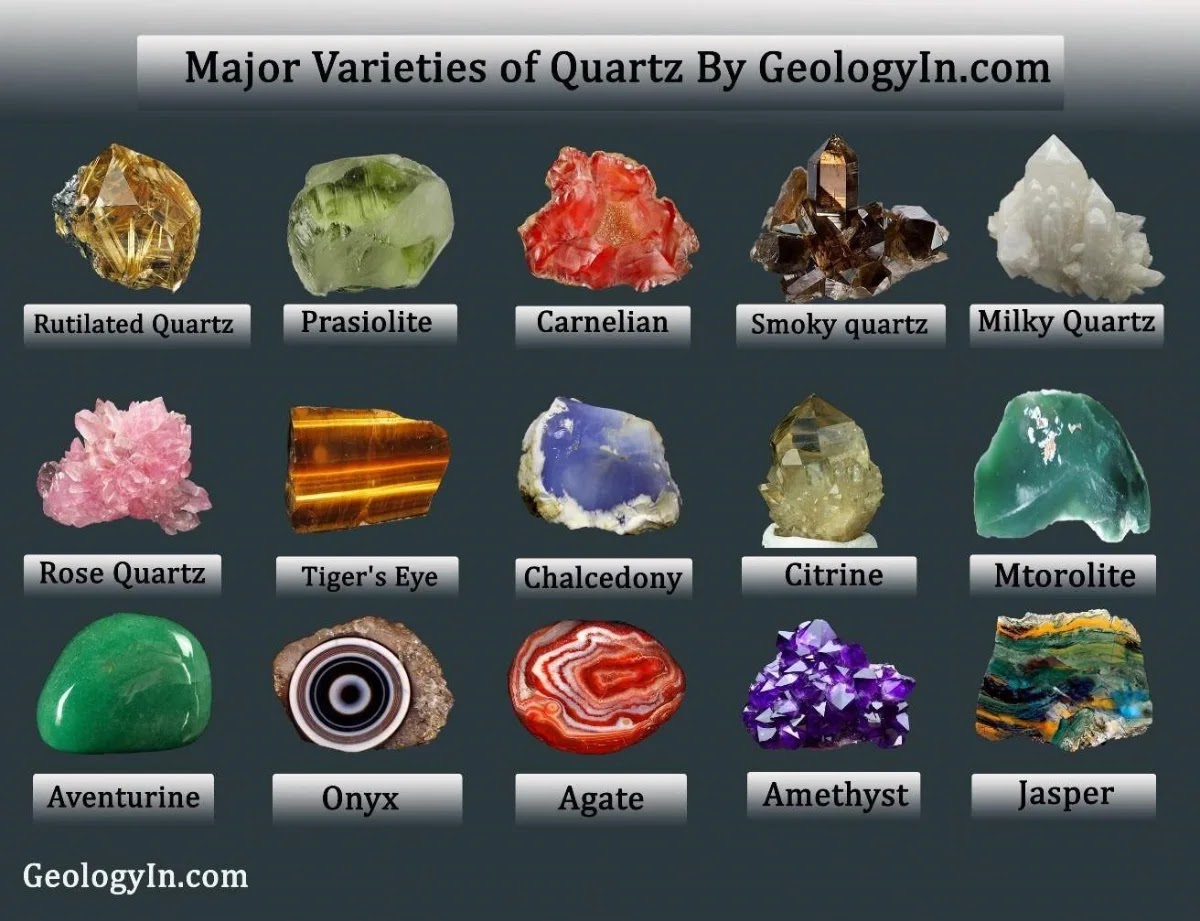Rutilated Quartz: Types, Colors, Uses
Rutile Quartz also known as, Rutilated quartz, is a captivating variety of quartz known for its inclusions of needle-like rutile crystals. These inclusions, often golden in color, create a mesmerizing effect within the quartz. Rutilated quartz is a valued gemstone due to its unique beauty, durability, and relative rarity.
Rutilated quartz, also known as "Hairy Quartz" or "Venus Hair Stone," is a captivating gemstone with a unique beauty that comes from its inclusions of rutile, a mineral made of titanium dioxide.
Rutile Quartz Formation
Rutilated quartz forms during hydrothermal processes, often associated with pegmatites. Hot, mineral-rich fluids flowing through cracks and fissures in rocks can deposit silica and other minerals, including rutile. As the fluids cool, crystals of quartz and rutile grow and intergrow within the cavities.
Hot, mineral-rich hydrothermal fluids containing dissolved silicon dioxide (SiO₂) and titanium dioxide (TiO₂) permeate fractures within rocks.
As the fluids cool, quartz crystallization occurs within cavities or vugs.
Depending on the concentration of TiO₂ and specific thermodynamic conditions, two scenarios can arise:
- Intergrown rutile: TiO₂ molecules integrate into the growing quartz lattice, forming needle-like rutile inclusions (e.g., Venus Hair, Sagenitic).
- Separate rutile crystals: TiO₂ crystallizes independently within the vug, potentially becoming incorporated into the quartz during further growth.
Properties of Rutile Quartz
Composition: Primarily silicon dioxide (SiO₂) with inclusions of titanium dioxide (TiO₂) in the form of rutile needles.
Color: The color of rutile quartz can vary greatly depending on the concentration and orientation of rutile inclusions. It can range from pale yellow and orange to deep golden brown, and even black. Some specimens may exhibit a stunning chatoyancy, a "cat's eye" effect caused by the light reflecting off the rutile needles.
Luster: Vitreous, meaning like glass with a bright and glassy shine.
Crystal System: Trigonal
Streak: White
Hardness: 7 on the Mohs scale, making it a relatively hard and durable stone.
Cleavage: Weak to absent
Crystal Form: Typically found in prismatic or pyramidal crystals, often with rough or uneven faces due to the inclusions.
Density: Approximately 2.6 to 2.7 g/cm³
Transparency: Can be transparent, translucent, or opaque depending on the concentration of rutile inclusions.
Fracture: Conchoidal, meaning it breaks with smooth, curved surfaces.
Specific Gravity: 2.6 to 2.7
Solubility: Insoluble in water and most common acids.
Magnetism: Non-magnetic
Fluorescence: May exhibit weak fluorescence under longwave ultraviolet light, ranging from yellow to orange.
Pleochroism: Weak to absent, meaning the color does not change significantly when viewed from different directions.
Refractive Index: 1.544 to 1.553 for ordinary ray and 1.553 to 1.557 for extraordinary ray, demonstrating a slight birefringence.
Rutile Quartz Types & Varieties
Rutilated quartz, with its captivating inclusions of rutile needles, displays a mesmerizing diversity within its own category. Here's a breakdown of some key varieties:
Based on Rutile Inclusion Distribution:
Venus Hair Rutilated Quartz
 |
| Venus Hair Rutile Quartz - Brazil |
Venus Hair Rutile: This variety features delicate, hair-like inclusions of rutile, resembling threads woven through the quartz. The rutile needles can be golden, silver, or black in color, adding a subtle shimmer to the stone. The fine needles form when tiny amounts of titanium dioxide from the hydrothermal fluid become incorporated into the growing quartz lattice.
Sagenitic Rutilated Quartz
 |
| Sagenitic Rutile Quartz |
Sagenitic Rutile: Mossy green or brown rutile inclusions, This popular variety showcases moss-like or fern-like patterns within the quartz due to intergrowths of rutile needles with other minerals like chlorite, actinolite, or epidote. The color ranges from greenish-brown to black, depending on the dominant mineral intergrowths. Sagenitic rutile forms during hydrothermal processes where specific geochemical conditions favor the growth of these intergrown minerals alongside rutile needles.
 |
| Sagenitic Rutile Quartz |
Star Rutilated Quartz
 |
| Star Rutile quartz |
Star Rutile: Features a mesmerizing six-rayed star pattern due to the radial arrangement of rutile needles within the quartz. This phenomenon, called asterism, creates a dramatic play of light when viewed from certain angles. The star can be golden, silver, or even colored depending on the rutile hue.
Crowded Rutilated Quartz
 |
| Crowded Rutile Quartz |
Crowded Rutile: Features an abundance of rutile inclusions filling the quartz, sometimes reducing transparency. The density can create a fiery sparkle or even render the stone opaque. The color depends on the rutile hue, ranging from golden to greenish-brown or even black. High concentration of titanium dioxide in the hydrothermal fluid leads to an abundance of rutile inclusions during quartz crystallization.
Based on Rutilated Color
Golden Rutilated Quartz
 |
| Golden Rutile in Smoky Quartz |
Golden Rutilated quartz: Most common color, Showcases vibrant golden rutile inclusions, adding a fiery glow to the quartz. These inclusions can be hair-like, mossy, or even star-like depending on the formation process. The golden color comes from the natural yellow-orange hue of rutile itself. Specific mineral intergrowths can also enhance the golden tone.
Red Rutilated Quartz
 |
| Red Rutile Quartz |
Red Rutile: This variety features distinct red rutile inclusions, ranging from fiery brick red to delicate orange-red hues. These inclusions can be hair-like (similar to Venus Hair) or form mossy patterns, resembling Sagenitic quartz.
The red color primarily comes from hematite intergrown with the rutile needles. This can happen alongside other minerals like goethite or lepidocrocite, contributing to the overall red coloration.
Black Rutile Quartz
 |
| Black Rutile Quartz |
Black Rutile: Very rare, appearing almost opaque due to the presence of other minerals like ilmenite within the inclusions.
What may appear black is often opaque rutilated quartz with dense, dark brown or greenish-black inclusions of rutile and other minerals like chlorite or actinolite. The dark color can arise from several factors, including dense intergrowths of various minerals, high concentration of rutile needles, or even iron oxide staining.
Silver Rutile Quartz
Silver Rutile: Rare, This captivating variety features shimmering silver-colored rutile inclusions within transparent or translucent quartz. The silver inclusions can range from bright metallic silver to a soft, almost bluish-grey hue depending on the light and the presence of other minerals. The silver color primarily comes from the natural hue of rutile itself, sometimes enhanced by intergrowths with other minerals like chalcopyrite or galena.
Other Varieties
Cat's Eye Rutile Quartz
 |
| Cat's Eye Rutile quartz |
Cat's Eye Rutile: Exhibits a chatoyant effect, showcasing a single band of light that moves across the stone as it is turned. This phenomenon arises due to the fibrous nature of some rutile inclusions or specific cutting techniques
Rutilated Smoky Quartz
Rutilated Smoky Quartz: Combines the smoky hue of quartz with the shimmer of rutile inclusions. The smoky color can range from pale brown to nearly black, while the rutile can be golden, silver, or even greenish-brown depending on the variety.
Rutilated Milky Quartz
Rutilated Milky Quartz: Rutile inclusions within milky quartz, Features milky white quartz with the added sparkle of rutile inclusions. The inclusions can be hair-like, mossy, or even star-like depending on the variety. The milky base softens the overall look and creates a delicate charm.
Rutile Quartz Occurrence
Rutilated quartz is a globe-trotting gemstone, found in a variety of locations around the world! Here are some of the key regions known for their rutilated quartz deposits:
Brazil: A leading producer, especially famed for its vibrant golden rutile quartz from the Serra da Mangabeira mountain range.
Madagascar: Renowned for its high-quality rutile specimens, including star rutile and sagenitic rutile with unique mossy inclusions.
Sri Lanka: Offers a range of rutile quartz colors, including golden, pink, and green, often with fine, hair-like inclusions.
Pakistan: Provides stunning rutilated quartz with bold rutile needles and occasionally rare varieties like chevron rutilated quartz.
Australia: Known for its unique "Mud Tank Zircon Field," which yields rutilated quartz with iridescent rainbow reflections due to microscopic hematite inclusions.
United States: Rutilated quartz deposits can be found in various states, including California, Colorado, and Vermont.
Norway: Home to rare and mesmerizing specimens with black rutile needles, known as "black venus hair."
Rutile Quartz Uses
Jewelry:
- Gemstone: Rutilated quartz is a popular choice for jewelry thanks to its stunning play of light, variety of colors, and relative durability. It can be found in rings, necklaces, earrings, pendants, and even carved into stunning figurines.
- Cabochons: The play of light in rutilated quartz is often best appreciated when cut and polished as cabochons, allowing the inclusions to shine through.
- Collectors' item: Rutilated quartz with unique inclusions or rare color combinations can be highly sought-after by collectors and enthusiasts.
Metaphysical and Healing Properties:
Some believe rutilated quartz possesses various metaphysical properties, including amplifying energy, cleansing negativity, and promoting spiritual growth. It is often used in meditation and healing practices.
Conclusion
The beauty of rutilated quartz lies in its captivating combination of natural elements. Each needle-like inclusion tells a story of geological processes and the unique formations that shaped this remarkable gemstone. So, the next time you encounter rutilated quartz, take a moment to appreciate its dazzling beauty and the intriguing story it holds within its sparkling depths.
Read also:
Phantom Quartz - Formation, Types, Colors, Properties
Ametrine - Gemstone, Properties, Formation, Occurrence







%20(1).webp)


